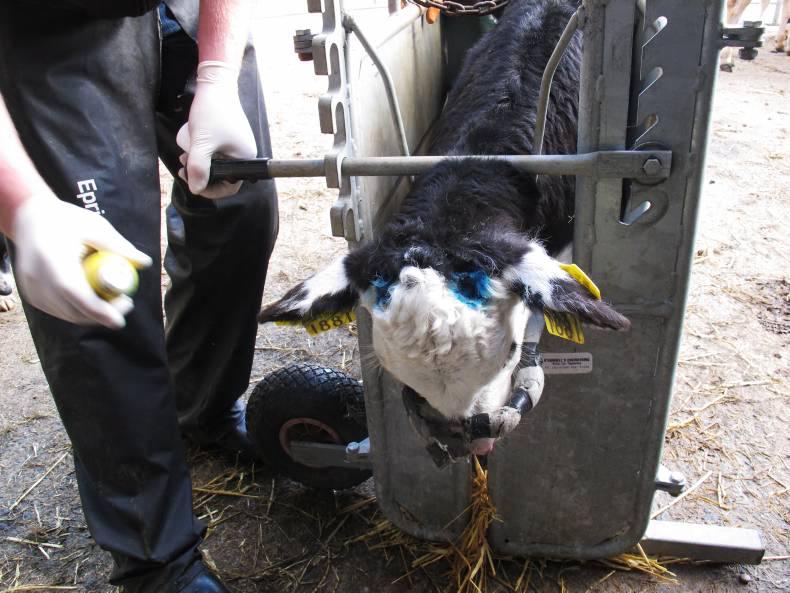Dehorning is highly beneficial from both a welfare and economic standpoint. Understanding the proper methods of dehorning in conjunction with adequate pain control can result in a low-stress and positive procedure for both the calf and the operator.
The aim of dehorning is to permanently destroy or remove the horn-producing cells at the base of the bud, to prevent further growth. In calves less than two months of age, horn buds are free-floating.
Eventually, the buds begin to grow and attach to the skull overlying the frontal sinuses. Then the horns acquire a blood supply. Dehorning at this late stage is more invasive, causes blood loss, and increases the risks of prolonged wound healing and infection.
The Department of Agriculture recommendation is that calves should be dehorned at less than two weeks old.
Department rules require that calves dehorned after this age need to be injected with an anaesthetic when completing the dehorning process (see video).
Having the right equipment can make the dehorning process easier for both operator and animal. A good dehorning crate allows the operator good control over the calf while the job is being completed.
In most crates, the calf’s head can be restrained so that the head is stationary when the job is being completed. This also allows the head to be tilted slightly forward, making it easier to clip, inject and dehorn the calf.
All dehorners operate best when they are red hot. For this reason, many dairy farmers will have two dehorners working when dehorning rather than waiting for the dehorner to heat up.
1. Blue spray – it is best to apply a wound-healing spray to the area of the head that has been dehorned once the job is complete. This keeps flies and other mites out and helps to heal the wound.2. Nice small sharp needle – Old calves will require 2cc of anaesthetic into the corneal nerve between the horn and the eye (see video). The recommendation is to use a 1.2mm x 25mm gauge needle.3. Crate – This crate gives great control of the calf and the calf’s head, limiting the stress on the calf and the operator during the dehorning process. 4. Gas refill – For hand-held dehorners, small bottles of replacement gas can be purchased. Hand-held dehorners need to be cleaned out regularly as carbon deposits can build up around nozzles, preventing them from heating up properly.
Dehorning is highly beneficial from both a welfare and economic standpoint. Understanding the proper methods of dehorning in conjunction with adequate pain control can result in a low-stress and positive procedure for both the calf and the operator.
The aim of dehorning is to permanently destroy or remove the horn-producing cells at the base of the bud, to prevent further growth. In calves less than two months of age, horn buds are free-floating.
Eventually, the buds begin to grow and attach to the skull overlying the frontal sinuses. Then the horns acquire a blood supply. Dehorning at this late stage is more invasive, causes blood loss, and increases the risks of prolonged wound healing and infection.
The Department of Agriculture recommendation is that calves should be dehorned at less than two weeks old.
Department rules require that calves dehorned after this age need to be injected with an anaesthetic when completing the dehorning process (see video).
Having the right equipment can make the dehorning process easier for both operator and animal. A good dehorning crate allows the operator good control over the calf while the job is being completed.
In most crates, the calf’s head can be restrained so that the head is stationary when the job is being completed. This also allows the head to be tilted slightly forward, making it easier to clip, inject and dehorn the calf.
All dehorners operate best when they are red hot. For this reason, many dairy farmers will have two dehorners working when dehorning rather than waiting for the dehorner to heat up.
1. Blue spray – it is best to apply a wound-healing spray to the area of the head that has been dehorned once the job is complete. This keeps flies and other mites out and helps to heal the wound.2. Nice small sharp needle – Old calves will require 2cc of anaesthetic into the corneal nerve between the horn and the eye (see video). The recommendation is to use a 1.2mm x 25mm gauge needle.3. Crate – This crate gives great control of the calf and the calf’s head, limiting the stress on the calf and the operator during the dehorning process. 4. Gas refill – For hand-held dehorners, small bottles of replacement gas can be purchased. Hand-held dehorners need to be cleaned out regularly as carbon deposits can build up around nozzles, preventing them from heating up properly. 





 This is a subscriber-only article
This is a subscriber-only article








SHARING OPTIONS: